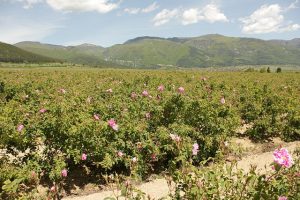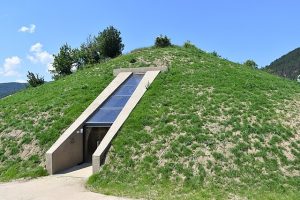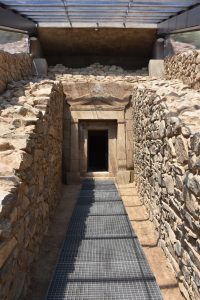In this series of posts, we will explore the sites in Southeastern Europe that are the modern-day counterparts to the ancient locales described and mentioned in our novel. We will also delve into what these sites offer visitors today!
You hear someone mention the Valley of the Kings. Images of rocky desert terrain begin to flash through your mind. Suddenly, the entrances to royal tombs tucked among the rocky cliffs reveal themselves to you in your mind’s eye. Royal tombs that are lavish and splendid; tombs that have stunning paintings and reliefs inside. This is the famous Valley of the Kings in Egypt, after all.
But did you know there’s another Valley of the Kings? One that’s lush and green, with roses growing all around. One that’s dotted with burial mounds and wedged between two mountain chains covered in dense forest. One that also witnessed rich royal funerals, processions, and feasts centuries ago. And one that sits underneath an imposing mountain top monument that resembles a spaceship. This is the other Valley of the Kings—the Thracian Kings—in Bulgaria.
Our third stop as we travel through time is…
The Valley of the Thracian Kings—the third ancient locale featured in The Mask!

Today, the Kazanlak Valley—named after its largest town—yields riches of a different kind. This time, it comes in the form of liquid gold: rose oil. The Kazanlak Valley produces around half of the world’s rose oil, an essential ingredient found in cosmetic and body care products used worldwide. Bulgarian rose oil, made from Damascena roses introduced to the Balkans during Ottoman Turkish rule, is known for its high quality and is highly coveted.
Every late May/early June, when the roses in the valley bloom, an annual Rose Festival is held. The festival is popular with visitors not just from Bulgaria, but from all over the world. Every year at the Rose Festival, in the midst of festivities steeped in Bulgarian traditions and folklore, a “Rose Queen” is crowned.
But remnants of the valley’s ancient past reside amidst the rose fields.

In 335 BCE, Alexander the Great led a force against a local Thracian tribe that was revolting against Macedonian rule and successfully routed them in a mountain pass near the valley. A little over a decade later, after the break-up of Alexander’s empire, a conflict over control of Thrace broke out between the forces of Lysimachus and Seuthes III. Lysimachus was a former bodyguard of Alexander’s who was allocated Thrace as his dominion after Alexander’s death and the division of the empire.
Seuthes III was a local ruler of the Odrysian Thracians who had begun rebelling against Macedonian rule when Alexander’s army was away in Asia. A battle between Lysimachus and Seuthes’s forces led to a stalemate, and it appears Seuthes won de facto control over part of inland Thrace, while Lysimachus’s domain was limited to the coastal regions of Thrace.
During this period of coexistence between Lysimachus’s foreign, coastal-based rule and Seuthes’s local, inland-based rule of Thrace, in either the late 4th century or early 3rd century BCE, Seuthes established his capital city, Seuthopolis, in what is today the Kazanlak Valley. The valley seems to have thereafter become the most important political center in Thrace, which explains why archaeologists have discovered a plethora of royal Thracian tombs that date back to this time period.
One of these, the Thracian Tomb of Kazanlak, is perhaps the best-preserved tomb in Bulgaria. The Kazanlak Tomb enchants visitors with its unique frescoes—splendid ancient artwork that serve as a portal to a time long past. These marvelous murals are a rare vivid depiction of life in ancient Thrace, left behind by the Thracians themselves. (Images of these frescoes can be found scattered throughout our website!)
The frescoes are a crucial factor in the Kazanlak Tomb’s status as a UNESCO (United Nations Educational, Scientific, and Cultural Organization) World Heritage Site. As a result, the tomb draws visitors from around the world. Unfortunately, in order to preserve the original paintings, a decision was made a few years back to close off the original tomb to the general public. Visitors may enter a nearby exact replica instead.

The UNESCO-listed tomb is not the only burial chamber in the valley open to the public. Another tomb worth visiting is that of King Seuthes III himself. A detailed bust of the king’s face was found by the late archaeologist Georgi Kitov outside the tomb; this magnificent sculpture partially inspired the design of the mask on the front cover of Cracking of the Mask. Seuthes’s tomb, with its impressive façade, long entry corridor, and three spacious rooms, stands as another silent testimony to the ancient Thracians’ mastery of tomb architecture.
The nearby Shushmanets Tomb, originally built as a temple and then used as a burial chamber, is also worth visiting for its Mediterranean-style architecture, including a Doric column found in the main chamber.
Unfortunately, Seuthopolis, the Thracian capital city founded by Seuthes III in the early 3rd century BCE, is now located at the bottom of the Koprinka Reservoir near Kazanlak. Plans to uncover and reconstruct the city are underway, as is the building of a dam wall which would enable visitors to see the city from above.
Thank you for traveling through time with us today! In our next post, we will explore additional sites in the Kazanlak Valley as well as other nearby destinations!

